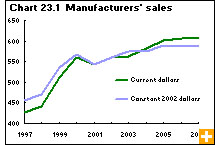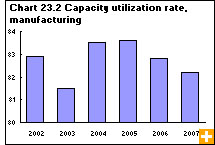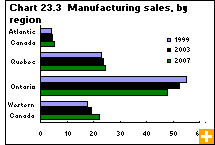Common menu bar links
Manufacturing industries
Archived Content
Information identified as archived is provided for reference, research or recordkeeping purposes. It is not subject to the Government of Canada Web Standards and has not been altered or updated since it was archived. Please contact us to request a format other than those available.
Manufacturing runs the gamut from frozen french fries to fine paper, cars to aluminum cans, microprocessors to motor oil—thousands of products for sale at home and abroad. In 2007, Canada’s manufacturing sales totalled $607.3 billion, and 2 million Canadians were employed in the sector. Although manufacturing remains a powerhouse in our economy, contributing 15% to gross domestic product (GDP) in 2007, the sector is undergoing fundamental change.
Employment in the sector has declined, industrial capacity is underutilised, and output in 2007 was down 1% for a second straight year, leaving it slightly higher than in 2002. Even so, increased industrial product prices and demand for resource-based goods have meant little change in either the value or volume of manufacturing sales. And with high demand for raw materials and record prices for specific natural resources, operating profits in 2007 halted a two-year downward trend, rising 5% to $45.0 billion, the highest it has been since 2004.
A sector in transition
The manufacturing sector has faced significant challenges in 2007, including fierce global competition, rising demand for key resources and the rapid strengthening of the Canadian dollar. The loonie’s value exceeded that of the U.S. dollar in September 2007 for the first time in 30 years, making Canadian-made exports to the United States more expensive and thus less competitive. For exporters of manufactured goods, that challenge was compounded by the U.S. subprime mortgage crisis and beckoning recession. For a second consecutive year, exports to the United States fell; this was partly offset by higher exports overseas and strong consumer demand in Canada.
Some industries benefit, others struggle
The changing dynamics in Canadian manufacturing highlight the changes the sector is undergoing. In 2007, 10 of 21 manufacturing industries reported improved sales. Benefiting from rising global demand, the petroleum and coal products industry reported sizeable gains, which were boosted by average annual prices that increased by about 65% from 2003 to 2007. With sales of $66.7 billion, petroleum and coal products accounted for 11% of total manufacturing sales in 2007. For the first time, this industry overtook motor vehicle manufacturing, becoming second only to the food industry in total manufacturing sales.
The second-biggest gainer in 2007 was primary metals. Sales by primary metal manufacturers reached $53.0 billion, as prices within the industry rose 10% compared with 2006. As well, 2007 saw a resurgence in Canada’s aerospace industry, a result of re-investment in global airline fleets and the awarding of several major defence contracts. Aerospace product and parts manufacturers reported a 3% gain in 2007, reaching a record $16.3 billion in production.
The hardest hit in a rapidly changing sector in 2007 was the wood products industry, where year-over-year sales fell 18% to $25.0 billion, the lowest since 1996. This industry in particular has been buffeted by the higher Canadian dollar, the decline in the U.S. housing market, rising energy costs and falling wood prices. Since 2004, wood product sales have dropped 30%.
The motor vehicle industry also continues to wane: 2007 saw its third consecutive annual decline. Sales fell 2.2% to $60.6 billion in 2007, less than the 7.5% sales drop in 2006. However, manufacturing sales of motor vehicles have fallen 23% from their peak of $78.3 billion in 1999. This trend results from the cumulative effect of the economic downturn in the United States, where approximately 90% of Canadian-made motor vehicles are sold; high gasoline prices; and the growing demand for more fuel-efficient vehicles rather than the larger autos and trucks that are among the models assembled in Canada.
Operating below capacity
Manufacturing plants are operating below capacity, a sign of the slowdown. The ‘capacity utilization rate’ is the ratio of actual output in a sector to its estimated potential output. In 2007, the average rate in the manufacturing sector was 82%, down slightly from 2006. Wood products manufacturing, in particular, operated well below capacity: the annual average rate in this industry in 2007 was 77%, well short of the record 92% in 2004. But wood product manufacturers were not alone; 18 of the 21 major industry groups in manufacturing saw reductions in 2007.
But making a profit
Despite the challenges, operating profits have stayed consistent in nominal terms since 1999. What has changed is the source of the profits. In 1999, the petroleum and primary metals industries accounted for 13% of total manufacturing profits. By 2007, their share had almost tripled to 37%. By contrast, motor vehicle and vehicle parts, and wood and paper products manufacturers, which made up 33% of total profits in 1999, dropped to 6% in 2007.
Provincial patterns
The changing nature of manufacturing is echoed in the provincial patterns. Ontario remains the manufacturing heavyweight. However, as the centre of Canada’s challenged auto industry, the province has been losing strength. Ontario still accounted for 48% of national manufacturing sales in 2007, but this was down seven percentage points from its 55% share in 1999. As well, while most provinces reported higher manufacturing sales in 2007 than the year before, Ontario posted its second straight decline, slipping 1.5% to $291.7 billion. This was Ontario’s lowest level since 2001.
Unlike Ontario, Quebec has enjoyed continued growth in manufacturing sales. In 2007, Quebec posted its sixth consecutive year of rising sales, buoyed by gains in primary metals, food and aerospace. At $148.3 billion, its share of the national total was 24%, up from 23% in 2005.
The four provinces west of Ontario accounted for 22% of total sales in Canada, up from 19% in 2003. Alberta is enjoying the impact of the petroleum and coal products industry on manufacturing sales: it leads the western provinces in sales growth. Alberta posted manufacturing sales of $65.6 billion in 2007, for its fifth successive annual increase. Alberta accounted for nearly one-half of Western Canada’s manufacturing sales.
In Newfoundland and Labrador, sales rose 20.7% in 2007 to $5.3 billion, making the province the main contributor to Atlantic growth.





